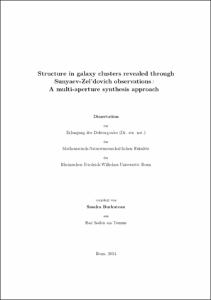Structure in galaxy clusters revealed through Sunyaev-Zel’dovich observationsA multi-aperture synthesis approach

Structure in galaxy clusters revealed through Sunyaev-Zel’dovich observations
A multi-aperture synthesis approach

| dc.contributor.advisor | Bertoldi, Frank | |
| dc.contributor.author | Burkutean, Sandra | |
| dc.date.accessioned | 2020-04-20T04:07:00Z | |
| dc.date.available | 2020-04-20T04:07:00Z | |
| dc.date.issued | 02.12.2014 | |
| dc.identifier.uri | https://hdl.handle.net/20.500.11811/6208 | |
| dc.description.abstract | As the largest bound objects in the universe, galaxy clusters are unique targets to study astrophysical processes, as well as powerful probes for precision cosmology. Galaxy clusters are dynamically young and their merger history and energetic feedback from galaxies leave significant traces in the pressure or entropy distribution of the intra-cluster medium (ICM), the hot plasma that contains most of the baryonic mass in clusters. A detailed understanding of how ICM observables relate to cluster mass at different cosmic epochs is also crucial to reduce the systematic uncertainties in the measurement of cosmological parameters from cluster observations. Through analysis of new observational data, mock observations, and modelling, I explore how current and future millimeter-wavelength interferometer observations of the Sunyaev-Zel’dovich effect (SZE) allow detailed studies of the ICM structure and physics. The SZE is a change in the emission spectrum of the Cosmic Microwave Background (CMB) caused by the scattering of CMB photons off the hot ICM free electrons. The SZE signal is proportional to the electron pressure and thus allows a measure of the thermal energy content and morphology of the ICM. I focus on the projected triaxial cluster morphology, whose extended structure is best observed at millimeter-wavelengths with a combination of interferometer and single-dish imaging observations. Interferometric observations provide good spatial resolution but suffer from sparse spatial sampling, which may hamper non-spherical cluster pressure profile constraints. Single dish observations are naturally limited in spatial resolution and commonly do not resolve the interesting cluster core regions or shocks in the ICM. My interferometric CARMA/SZA SZE observations of the galaxy cluster MS0451 complement our prior single-dish APEX observations. While the small-dish interferometric SZA data offer better precision in spherical pressure profile fits, they suffer from insufficient interferometric spatial sampling, which does not allow to constrain the projected elliptical shape and orientation of MS0451. APEX-SZ data thus complement the interferometric fits, as they can constrain the non-spherical projected morphology. The ICM in the core regions of clusters retains signatures of AGN energy feedback and merger-induced disturbance. The unrivaled high resolution and sensitivity of the new Atacama Large Millimeter Array (ALMA) and its compact sub-array (ACA) offer unique capabilities to study cluster cores and merger-induced shock fronts. Through mock simulations of ALMA and SZA observations and using my Bayesian MCMC code, I show that it is possible to distinguish different morphological states of clusters through their characteristic, observable pressure profiles. In addition, I quantify how future ALMA lower frequency (Band 1) observations can strengthen the present capability to measure the cluster pressure distribution. My simulations also outline how ALMA observations provide detailed views on shock fronts in the ICM. The famous Bullet Cluster is taken as an example case, for which ALMA/ACA Cycle 2 configuration simulations illustrate how the merger-induced bow shock structure can indeed be imaged. | en |
| dc.language.iso | eng | |
| dc.rights | In Copyright | |
| dc.rights.uri | http://rightsstatements.org/vocab/InC/1.0/ | |
| dc.subject | Sunyaev-Zel'dovich-Effekt | |
| dc.subject | Galaxienhaufen | |
| dc.subject | Interferometrie | |
| dc.subject | Intracluster-Medium | |
| dc.subject | Druckprofil | |
| dc.subject | Schocks | |
| dc.subject | Sunyaev-Zel'dovich effect | |
| dc.subject | galaxy clusters | |
| dc.subject | interferometry | |
| dc.subject | intracluster medium | |
| dc.subject | pressure profile | |
| dc.subject | shocks | |
| dc.subject.ddc | 520 Astronomie, Kartografie | |
| dc.title | Structure in galaxy clusters revealed through Sunyaev-Zel’dovich observations | |
| dc.title.alternative | A multi-aperture synthesis approach | |
| dc.type | Dissertation oder Habilitation | |
| dc.publisher.name | Universitäts- und Landesbibliothek Bonn | |
| dc.publisher.location | Bonn | |
| dc.rights.accessRights | openAccess | |
| dc.identifier.urn | https://nbn-resolving.org/urn:nbn:de:hbz:5n-38457 | |
| ulbbn.pubtype | Erstveröffentlichung | |
| ulbbnediss.affiliation.name | Rheinische Friedrich-Wilhelms-Universität Bonn | |
| ulbbnediss.affiliation.location | Bonn | |
| ulbbnediss.thesis.level | Dissertation | |
| ulbbnediss.dissID | 3845 | |
| ulbbnediss.date.accepted | 14.08.2014 | |
| ulbbnediss.institute | Mathematisch-Naturwissenschaftliche Fakultät : Fachgruppe Physik/Astronomie / Argelander-Institut für Astronomie (AIfA) | |
| ulbbnediss.fakultaet | Mathematisch-Naturwissenschaftliche Fakultät | |
| dc.contributor.coReferee | Klein, Ulrich |
Files in this item
This item appears in the following Collection(s)
-
E-Dissertationen (4337)




